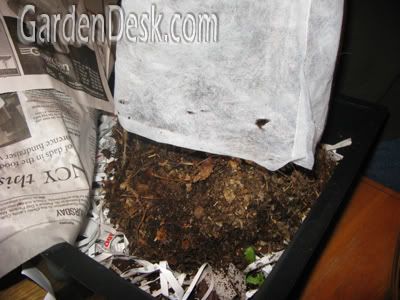The Worms are Doing Great!
My 1,000 new worms are safely settled in to their new home! These great red wiggler worms arrived just after my post about putting our new worm bin together. They are doing great in the new Gardens Alive Worm Factory!

The worms seem happy and healthy. I think it is because the Worm Factory came with great instructions on how to set up the bedding to give the worms their best possible home. It also came with a block of coir, which has turned out to be a great bedding. I didn't know what coir was, but I found out from The Worm Book that it is the shredded fiber of coconut husks.

When you add water to the coir, it instantly swells up! My kids got a kick out of watching it grow so quickly.

After it soaked up the water, I broke it apart and made sure it had even moisture.

The Worm Book by Loren Nancarrow and Janet Hogan Taylor, lists the advantages of using coir coconut fiber in worm bins. It says coir (also called coia) is great because it retains moisture like peat moss but of course is more of a renewable resource than peat. Coir also mixes well with other bedding, is odor free and clean, doesn't compact in the bin and has a good pH of 6 to 6.5. Nancarrow and Taylor states that the disadvantage of coir is that it is expensive. This worried me a bit because I want to buy additional coir for the bedding in the other trays of my worm bin. In the small quantities that I need for worm farming, cost is not bad. I found the same size brick of coir at Pinetree for $2.95.
After the coir was evenly moist, I added some crushed egg shells and put the whole mix in the worm bin tray.

Next came a layer of shredded paper.

The last step to making the worm bed was to add a couple sheets of moistened newspapers. This is a great idea since it helps to keep the material underneath moist as well. It will also be easier to tell when I need to add water to the whole worm bin.

Finally, it was time to add the worms!


Every day since, we have added vegetable kitchen scraps in one side of the bin. You need to bury the scraps so the worms have easy access to them and so they don't smell. It has been shocking how fast soft foods like strawberry tops and eggplant pieces are consumed. Potato peelings and lettuce have been slower. In a weeks time, the worms have also digested much of the shredded paper and I assume they are also eating the coir.
I guess I should have stated this at the beginning, but this is the whole reason to have a worm bin. We have it located right in the kitchen so we can add compostable food scraps quickly and often. Each worm eats its body weight in food each day! Over time, the worms will supply us with rich vermicompost that we can add to the garden! Worm castings are amongst the best of organic soil conditioners.
I will write more about the benefits of raising worms as I learn more about them. Like I mentioned earlier, I am reading The Worm Book . I am also re-reading the classic Mary Appelhof book, Worms Eat My Garbage: How to Set Up and Maintain a Worm Composting System
.
I was also able to find a new book on raising worms as a business called Profitable Earthworm Farming. A similar book, Raising Earthworms for Profit
was actually the first worm book I read. It is a great book which got me very excited about raising worms! I'm not sure that I want to be in the worm-selling business, but I do want to expand my worm farming as much as possible in order to get more worm castings from them. These books will help me turn my 1,000 worms into 15,000 worms in a year. If I create space for them, in two years I could potentially have half a million worms! That's a lot of vermicompost! I definitely don't want to buy any more redworms. They are sold for up to $50 per pound (1,000 worms). At least I found a pound of worms available for $29.99.
Maybe they would be good to raise for profit. Discussion for another day.
In the meantime, I will feed and visit my worm bin daily. Even our cats like to watch them wiggle.

I want to keep them healthy so I don't need to buy any more. There is one thing I would like to purchase for them though. I worry that I'm injuring them when I dig my hand through them to bury the food. I want to buy a Hand Compost Turner Tool. It is only $4.95 and using it would be safer for the worms. They probably sell this so you don't have to touch the worms. That doesn't bother me.

Don't they look great? I know, I'm like a proud pet owner. I'm sure I'll write more about them later!














0 comments:
Post a Comment